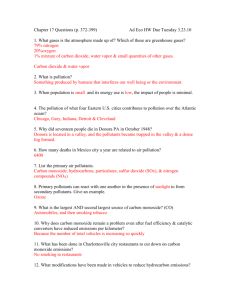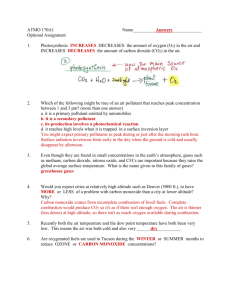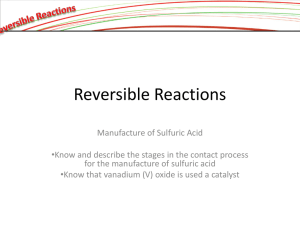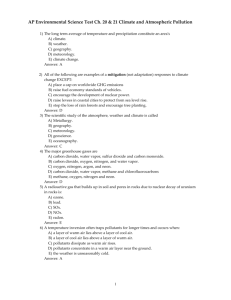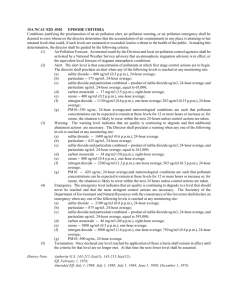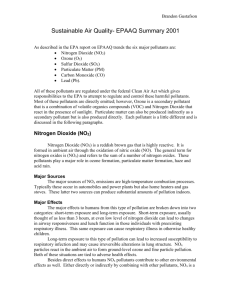The 6 Major Pollutants
advertisement
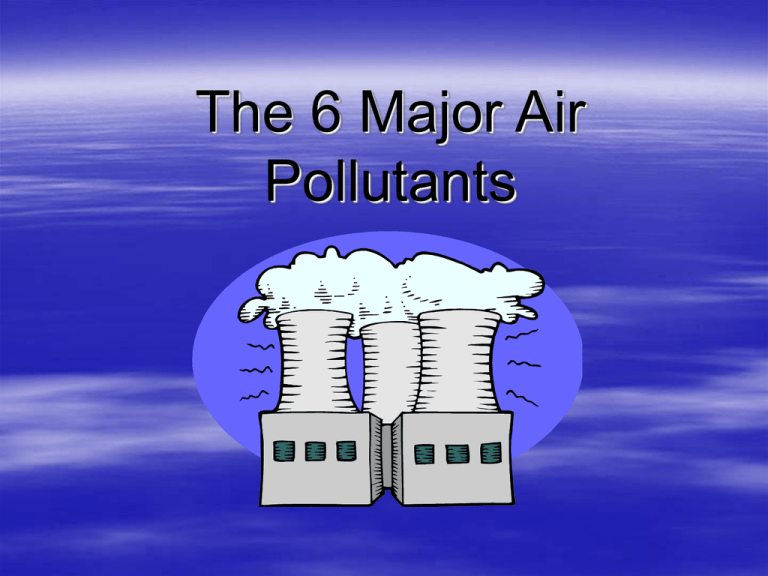
The 6 Major Air Pollutants OZONE A gas that forms in the atmosphere due to the burning of fossil fuels (gas, diesel, coal, wood). Can be “good” up in the atmosphere by protecting humans from UV rays, but “bad” near the ground because it is a dangerous pollutant. http://www.epa.gov/oar/oaqps/gooduphigh/ Ozone’s Impact on Health Attacks lungs in a way that is compared to getting a “sunburn” on the lungs. In doing so, can cause: – – – – – – premature death shortness of breath wheezing and coughing increased susceptibility to respiratory infection increased risk of asthma attacks increased need for medical treatment and hospital admission for people with chronic lung conditions such as asthma. Who Is Most at Risk From Ozone? Children Anyone with asthma, emphysema or chronic bronchitis Senior citizens CARBON MONOXIDE An odorless, colorless, poisonous gas that comes mainly from motor vehicles and other combustion exhaust Carbon Monoxide’s Impact on Health Interferes with the blood’s ability to carry oxygen to the brain, heart and other tissues. As a result, carbon monoxide inhalation can result in: – – – – chest pain vision problems damage to nerves especially dangerous for those with preexisting conditions, as well as newborn/unborn children http://www.epa.gov/air/urbanair/co/hlth1.html NITROGEN OXIDE AND NITROGEN DIOXIDE Both are produced when fuel (gas, kerosene) is burned, especially in power plants and motor vehicles. These oxides help ozone formation, and are a health problem themselves too. This gas changes in the atmosphere to form acidic particles and liquid nitric acid, and a reddish-brown layer can be seen over urban areas where it forms. http://www.epa.gov/air/urbanair/nox/ Nitrogen Oxide and Dioxides Impact on Health Affects the body like both ozone and sulfur dioxide Generates water pollution through acid rain Causes damage to lung tissue Causes deterioration of cars, buildings, vegetation, and crops http://www.epa.gov/air/urbanair/nox/hlth.html SULFUR DIOXIDE Created mainly when fuel containing sulfur (such as coal and petroleum) is burned in power plants and diesel engines. Like nitrogen dioxide, sulfur dioxide can change in the atmosphere into acidic particles and into sulfuric acid. Sulfur Dioxide and Your Health Sulfur dioxide inhalation constricts air passages– posing a serious health risk to young children. Even exposure to low levels of sulfur dioxide can trigger asthma attacks and associated health problems in asthma sufferers. Sulfur dioxide causes haze and acid rain, resulting in plant and water damage. http://www.epa.gov/air/urbanair/so2/hlth1.html PARTICULATE MATTER Particulate matter is microscopic particles and tiny droplets of liquid resulting from the burning of fuels by industry and diesel vehicles and from earthmoving activities such as construction and mining. Particulate Matter: The Public Health Risks Larger particles can be stopped in the nose and upper lungs by the human body’s natural defenses. The smallest particles dodge the body’s defenses and delve deep into the lungs, where they may become trapped. Exposure can cause wheezing and other symptoms in people with asthma or otherwisesensitive airways. Has been linked to increased hospital admissions and emergency room visits for respiratory problems (asthma attacks, bronchitis, sinus infections) and to a major increase in early deaths. http://www.epa.gov/air/particlepollution/health.html LEAD Classification as a poisonous substance has lead to the elimination of lead from gasoline, decreasing its concentration in outdoor air. Continuing sources of lead in the environment are: lead smelters, incineration of lead batteries, and burning lead contaminated waste-oil. Today, the most common sources of lead exposure are from contaminated soil and homes built before 1975 that were painted using lead paint. Lead’s Impact on Health Affects blood’s ability to carry oxygen Can impact nervous system, kidney function, immune system, and development systems Can have negative neurological effects in children, spurring behavioral problems and learning deficits Can cause high blood pressure and heart disease in adults http://www.epa.gov/air/lead/health.html For more information on the 6 major air pollutants please visit: http://www.epa.gov/air/urbanair/
